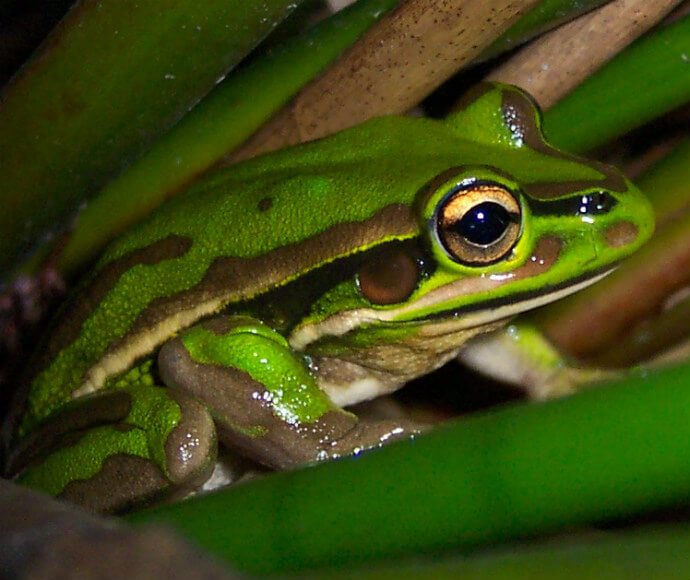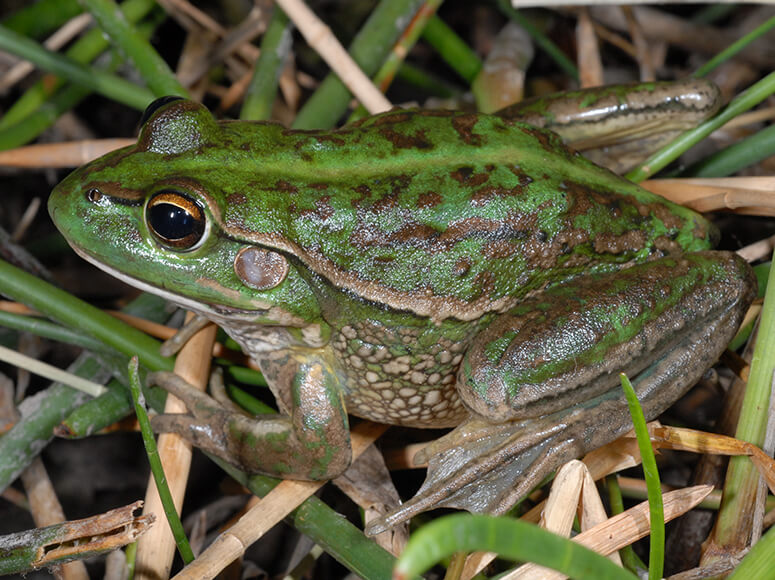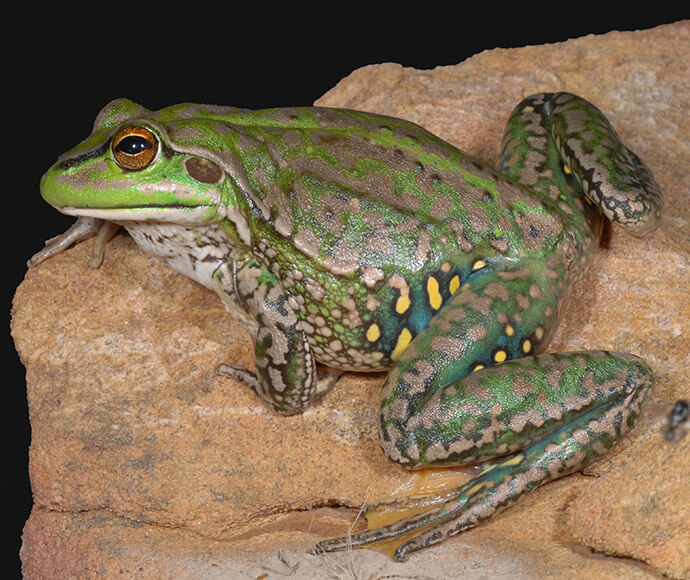What do bell frogs look like?
Bell frogs are large, distinctive green frogs. Adult males grow to 5 to 7 centimetres in length. Females are generally larger, at 6 to 10 centimetres in length.
Green and golden bell frog
Green and golden bell frogs (Litoria aurea) are smooth-skinned with bright green backs and varying sized golden blotches. A gold line runs from the snout over the eye to the hind leg. The groin and backs of the thighs are bright turquoise to blue-green.

Green and golden bell frog (Litoria aurea)
Southern bell frog
Southern bell frogs (Litoria raniformis) are bright emerald to dull olive green with brown or golden marbling. Their backs are very warty, not smooth, and often have a series of black spots on either side of the pale green stripe running down the middle. The groin and thighs are usually turquoise-blue or with a few small pale yellow spots.

Southern bell frog (Litoria raniformis)
Yellow-spotted bell frog
Yellow-spotted bell frogs (Litoria castanea) can be identified by large yellow spots on the groin and the backs of the thighs. They have warty backs with a pale green stripe running down the middle.

Yellow-spotted bell frog (Litoria castenea)
What do they sound like?
Male bell frogs call during the breeding season in spring and summer, and several males will often call together in a chorus. The three bell frogs have a similar call:
- The call of the green and golden bell frog is described as a long growl of several seconds duration, followed by a series of short grunts: 'cr-a-a-aw-a-a-awk, cra-a-a-awk, crok, crok'.
- For the southern bell frog, the call is more a series of low guttural 'grunts', sometimes lengthened into a growl.
- The yellow-spotted bell frog's call is said to resemble a distant motorbike, with a series of loud grunts.
You can hear bell frog calls on the FrogID website.
Where do they live?
These 3 species of bell frog are found in bulrushes and other emergent vegetation in or at the edges of permanent or semi-permanent water. Lakes, dams, ponds, swamps, wetlands, slow moving streams, drains, culverts and other human modified environments that hold water may all provide suitable habitat.
By day, the frogs rest on reeds or bask on grassy banks. By night, adults are active on grassy banks or floating on the water's surface. Warm nights, especially following rain, are good times to listen for bell frogs calling. During autumn and winter, they shelter under fallen timber, rocks, other debris or thick vegetation.
What do they eat?
Bell frogs will feed on a variety of prey, such as:
- tadpoles
- other frogs, including members of the same and other species
- small fish
- water snails
- a range of insects, including flies, beetles, beetle larvae and grasshoppers.
Breeding
The breeding cycles are similar for the 3 species of bell frog in New South Wales. The bell frog breeding season is generally from September to February, and they usually lay their eggs in pools or ponds during spring and summer. Their eggs are laid in a clear gel, not in a white foamy mass like those of many other frogs.
The tadpoles and juvenile frogs can be identified by the following traits:
- Green and golden bell frog tadpoles grow rapidly and become quite big, up to about 4 centimetres long, including the tail. When fully grown, the tadpoles have the same cream stripe as the adults along their sides, and a green tinge on their back. Juvenile frogs take around 12 weeks to develop after eggs are laid.
- The southern bell frog's newly hatched tadpoles are usually greyish-black or dark brown. They are green or golden in the latter stages of development. The tadpoles grow to about 10 centimetres long and take anywhere from 2 months to 1.5 years to fully develop.
- The yellow-spotted bell frog tadpoles are large, growing to about 8 centimetres long, with a pinkish-grey body and yellowish fins.
Decline in numbers
There is considerable concern about the disappearance and decline of bell frogs in New South Wales. Some species can no longer be found in areas where they used to occur.
Green and golden bell frog distribution
The green and golden bell frog used to be common along the coast and adjacent tablelands from northern New South Wales to East Gippsland in Victoria. Their distribution has declined dramatically and they now occupy only about 10% of their former range, mostly along the coast. Only one population is known from the Southern Tablelands.
Southern bell frog distribution
The southern bell frog was formerly widespread and abundant on the Southern Tablelands of New South Wales, from around Canberra south to Victoria. In New South Wales, they are now only known from the Riverina region west of the Great Dividing Range. They are also found in Victoria and Tasmania.
Yellow-spotted bell frog distribution
The yellow-spotted bell frog used to be found on the South-Eastern Highlands of New South Wales, from Lake George south to the Bombala area. There are also unconfirmed records from near Orange and Bathurst. The species also occurred on the New England Tablelands. Yellow-spotted bell frogs have not been seen in the wild since the 1970s.
Threats
The green and golden bell frog, southern bell frog and yellow-spotted bell frog are now considered endangered in New South Wales because they have disappeared from many areas where they used to occur. The reasons for the decline of these frogs are not well known. However, some possible causes include:
- the loss or modification of natural wetlands and swamps
- changes to natural water flows and water quality
- predation of eggs or tadpoles by introduced fish
- predation of frogs by foxes and cats
- disease, including the chytrid fungus
- climate change, including increased ultraviolet radiation (UVB)
- the use of herbicides or pesticides.
Protection of native animals
All native birds, reptiles, amphibians and mammals, but not including dingoes, are protected in New South Wales by the Biodiversity Conservation Act 2016.